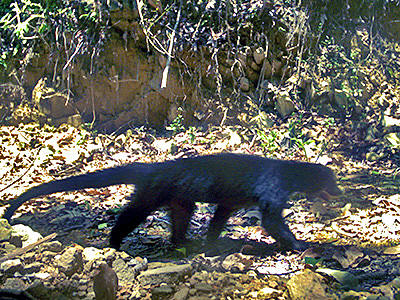 |
Order : CARNIVORA
Family : Viverridae
Species : Arctictis binturong
Head-body length : 65-95 cm
Tail length : 500-800 cm
Weight : up to 20 kg
The Binturong, or Bearcat, is a highly distinctive
and easily recognised member of the civet family. It is mainly restricted to
primary or tall secondary forest, but it can also survive in
grassland-forest mosaic. It is not known to occur in plantations such as rubber or
oil palm.
This unusual animal is mainly arboreal in habits, spending the day resting
amongst tree branches or in a tree hole. Only occasionally is it seen on the
ground.
At night the Binturong becomes more active as it searches for food: its diet
comprises ripe figs and other fruits, but it also preys on small
vertebrates, such as birds and rodents, as well as large insects.
Its body is muscular, and its tail is long and prehensile. Its head is
relatively small, and its ears are small and rounded. Its fur is long and
black, sometimes grizzled around the head, neck and lower flanks (i.e. each
hair may be tipped with white).
The Binturong ranges from parts of northeastern India and adjacent
territories (including Bangladesh, Bhutan and Nepal) and southern China
through Myanmar, Thailand, Laos, Cambodia, Vietnam, Peninsular Malaysia,
Sumatra, Java, Borneo and the island of Palawan in the southern Philippines.
It is classified as 'vulnerable' as a result of habitat loss and
over-hunting (Wilcox et al, 2016).
Although the species was first described by Sir Stamford Raffles, the
founder of Singapore, in 1821 (as Viverra binturong), it is unclear
whether it was once a native species there: there are no historical or
modern records from
the country.
Fig 1 :
Trail camera image of a Binturong from
lowland, primary forest in Peninsular Malaysia. Such
images have shown this animal to be more terrestrial than was once thought
(although it is primarily arboreal).
Image use courtesy
MYCAT ©.
References :
Francis, C.M. 2019. A Field Guide to the Mammals of South-east Asia. Second
Edition. New Holland. 416 pp.
Lekagul, B., McNeely, J., 1977. Mammals of Thailand. Association for the
Conservation of Wildlife, Thailand. 758 pp.
Willcox, D.H.A. et al. 2016. Arctictis binturong. The IUCN Red List
of Threatened Species 2016: e.T41690A45217088
|